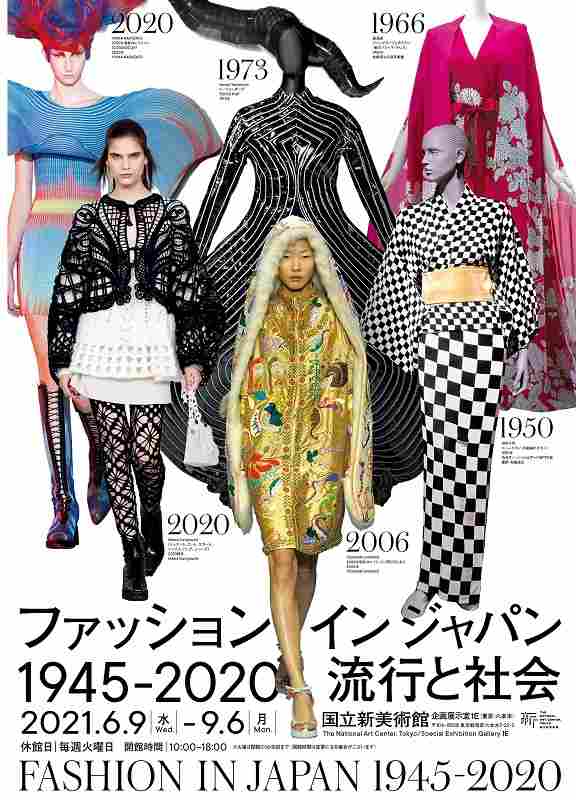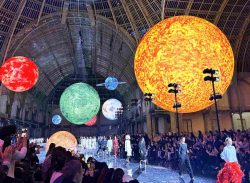
Three Comme des Garcons costumes designed by Rei Kawakubo for the Vienna State Opera production of “Orlando” in 2019 are seen in front. (The Kyoto Costume Institute)
10:30 JST, August 6, 2021

A leaflet for the exhibition “Fashion in Japan 1945-2020” at the National Art Center, Tokyo
The large-scale exhibition “Fashion in Japan 1945-2020” is ongoing at the National Art Center, Tokyo, allowing visitors to learn about the nation’s history of modern fashion — from its early days all the way through to the latest trends — along with glimpses of society during each era.
The show at the museum, located in Tokyo’s Minato Ward, is distinctive in that it introduces not only fashions of designer and corporate brands, but also various fashion cultures through media including photographs, motion pictures, magazines and music.
The exhibition, scheduled to run through Sept. 6, was curated by the museum’s curator Yayoi Motohashi and is chronologically divided into nine sections:
1. the 1920s-1945: From Traditional Japanese Clothing to Modern Dressmaking
2. 1945-the 1950s: The Postwar Heyday of Dressmaking
3. the 1960s: From “Making” to “Buying” Clothes
4. the 1970s: The Rise of Individualistic Japanese Designers
5. the 1980s: The Golden Age of “DC Brands”
6. the 1990s: New Styles from Shibuya and Harajuku
7. the 2000s: Kawaii Goes Global, and Social Media Takes Over
8. the 2010s: Toward a “Nice” Age
9. Fashions of the Future
Japanese fashion is overall shown in a positive light, with particular tribute paid to designers who made their names in the 1970s, such as Hanae Mori and Kansai Yamamoto. As most of the exhibits feature the work of fashion designers, the five Heattech thermal undershirts from Uniqlo on display catch the eye.
In my opinion, in the two decades from 1970, Japanese fashion became completely focused on catching up with its Western counterpart. This was true of not only corporate fashion brands but also among individual designer labels for whom distinctiveness and originality were their selling points. I think that extensive efforts toward that goal caused distortion, which became apparent after the collapse of the bubble economy in the early 1990s.
One notable example is Sanyo Shokai Ltd., which has been unable to get out of the red after failing to renew its licensing contract with Burberry in 2015, a contract it held for 46 years. Sanyo Shokai was one of many Japanese apparel makers that couldn’t resist the temptation of entering licensing contracts with Western fashion brands. As a result, they neglected to put forth any effort to pursue originality. There were also many instances of labels basing their designs on imitating popular contemporary Western designers.
Although fashion in Japan is now paying the price for its habit of emulating the West, two brands are outshining the rest: Uniqlo and Comme des Garcons. Uniqlo, which initially emulated brands such as GAP and Levi’s, finally established a basic casual style just for Japan and has become a global force to be reckoned with, as its overseas sales exceed domestic sales. Comme des Garcons has blazed a trail all its own, transcending the boundaries of fashion and reaching the realm of art. The brand’s founder, Rei Kawakubo, 78, is now the only surviving truly avant-garde fashion designer in the world.
The exhibition offers a look at Japanese fashion from the 90s on in the three time frames listed above. But, have the most recent fashion trends gained their own clear sense of originality over those 30 years? At the very least, the overarching sense of national identity has disappeared from contemporary fashion as a whole.
What’s more, it seems to me that fashion is entering an era of mishmash based on diversity and sustainability. This indeed makes for an interesting exhibition that’s sure to make visitors think.
"Culture" POPULAR ARTICLE
-

Van Cleef & Arpels Dazzles with Art Deco Artisanry at Tokyo Exhibit
-

Disney’s ‘Twisted-Wonderland’ Animated Series Puts Villains in Spotlight: New Show Features School Inspired by Classic Disney Films
-

Ayumi Hamasaki’s Shanghai Concert Canceled Day Before Schedule as Part of Beijing Backlash
-

‘The World Masterpiece Theater Series’ Celebrates 50 Years; Animator Looks Back on Creating Anime Classics
-

Popularity of Piggy Banks Across Time and Place Seen at Bank’s Museum of Money Boxes in Hyogo Pref.
JN ACCESS RANKING
-

Tokyo Economic Security Forum to Hold Inaugural Meeting Amid Tense Global Environment
-

Keidanren Chairman Yoshinobu Tsutsui Visits Kashiwazaki-Kariwa Nuclear Power Plant; Inspects New Emergency Safety System
-

Imports of Rare Earths from China Facing Delays, May Be Caused by Deterioration of Japan-China Relations
-

University of Tokyo Professor Discusses Japanese Economic Security in Interview Ahead of Forum
-

Japan Pulls out of Vietnam Nuclear Project, Complicating Hanoi’s Power Plans


























